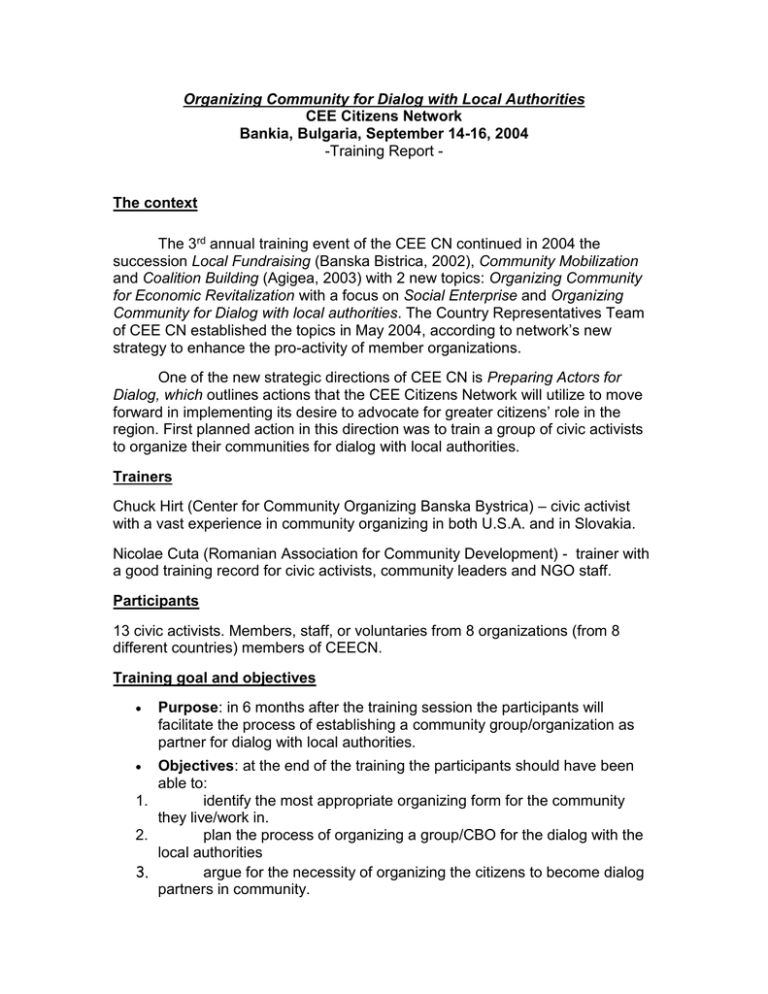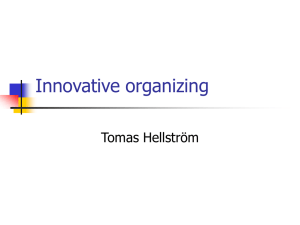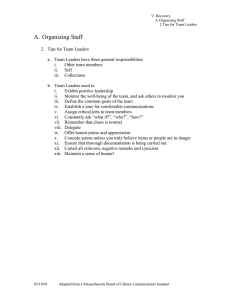Report-Dialog_with_LA.doc
advertisement

Organizing Community for Dialog with Local Authorities CEE Citizens Network Bankia, Bulgaria, September 14-16, 2004 -Training Report - The context The 3rd annual training event of the CEE CN continued in 2004 the succession Local Fundraising (Banska Bistrica, 2002), Community Mobilization and Coalition Building (Agigea, 2003) with 2 new topics: Organizing Community for Economic Revitalization with a focus on Social Enterprise and Organizing Community for Dialog with local authorities. The Country Representatives Team of CEE CN established the topics in May 2004, according to network’s new strategy to enhance the pro-activity of member organizations. One of the new strategic directions of CEE CN is Preparing Actors for Dialog, which outlines actions that the CEE Citizens Network will utilize to move forward in implementing its desire to advocate for greater citizens’ role in the region. First planned action in this direction was to train a group of civic activists to organize their communities for dialog with local authorities. Trainers Chuck Hirt (Center for Community Organizing Banska Bystrica) – civic activist with a vast experience in community organizing in both U.S.A. and in Slovakia. Nicolae Cuta (Romanian Association for Community Development) - trainer with a good training record for civic activists, community leaders and NGO staff. Participants 13 civic activists. Members, staff, or voluntaries from 8 organizations (from 8 different countries) members of CEECN. Training goal and objectives Purpose: in 6 months after the training session the participants will facilitate the process of establishing a community group/organization as partner for dialog with local authorities. Objectives: at the end of the training the participants should have been able to: 1. identify the most appropriate organizing form for the community they live/work in. 2. plan the process of organizing a group/CBO for the dialog with the local authorities 3. argue for the necessity of organizing the citizens to become dialog partners in community. The objectives were well accepted by all the participants, most of there training expectations being orientated to these. Content The training approached the community organizing process, step by step with practical examples provided by Chuck Hirt from his personal experience. The training sessions were focused on main stages of the community organizing process: community organizing as specific methodology of community work, methods to identify community issues, planning the strategy, getting support from community, tactical methods in community organizing. Results The participants identified the deep changes that are necessary in communities (mentalities, more courage and initiative for citizens, a more balanced power proportion between authorities and community). They concluded that the bottom-up changes in community are more sustainable. The trainees analyzed 2 interviews (role-play) and expressed their will to try this method in community. The trainers clarified for the participants the difference between problem and issue. Though they were able to correctly identify and define issues from their communities. The participants developed together a feasible community organizing strategy for a real issue from a Romanian community (Sibiu). Training methods The trainees worked in small groups (3-5 people) to identify what and why should be changed in their communities and to define a community issue. The differences between bottom-up and top-down changes in community were punctuated in a facilitated discussion. Participants practiced the community interview through a role-play. The trainers made short presentations on the public sphere chart, steps of community organizing methodology, selection criteria for a community issue, stakeholders’ analysis, the strategy chart. The trainees experienced the leadership styles trough a team game. The participants developed a community organizing strategy for a case study presented by one of them. Group Dynamic Though some participants had a limited command of English, only 2 of them needed permanent translation and were less active than the others in the large group sessions. All actively participated at the small groups discussions and team activities. Participants’ motivation helped them to surpass the language barrier, though the training was very animated. There were no conflicts or competition among participants. Trainers’ evaluation and recommendations Though the participants demonstrated they accomplished the 3 learning objectives, the purpose of the training will be fulfilled only if they will have the chance to put in practice in communities what they learned at the training. For this, participants’ organizations should be contacted and encouraged to create this opportunity for the participants they sent to training. Another important follow-on element is to stimulate and maintain the contact between participants. They left the training with a good subjective competence. If we’ll keep the group stimulus, they are more likely to try to apply what they learned. Putting all of them on ceecn e-group or creating a new one for them could be one solution. Finding mentors for them could be another one.

